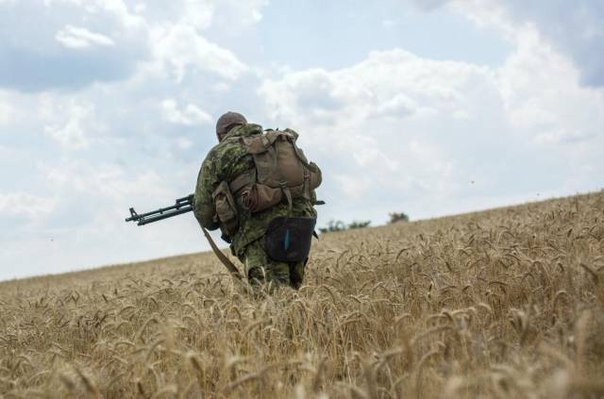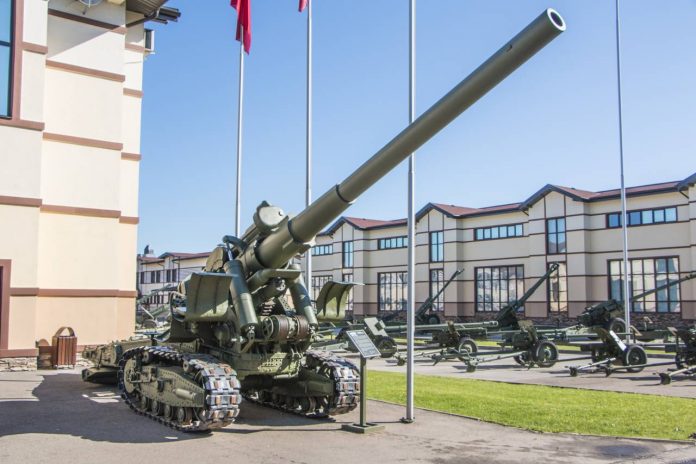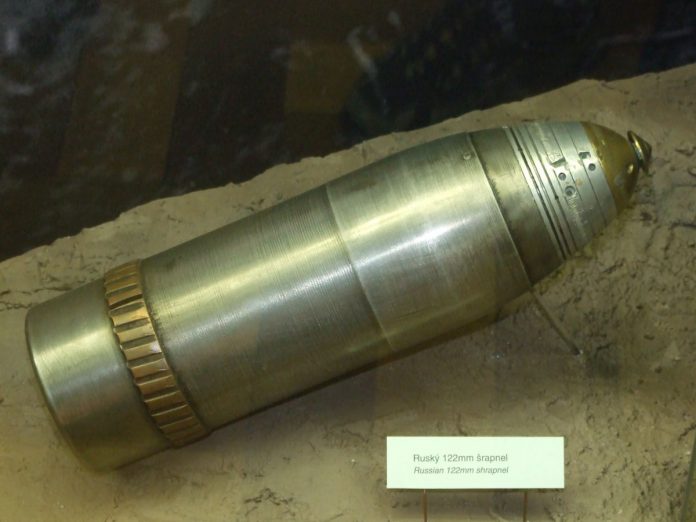 Russian 48-line (122-mm) shrapnel shell
Russian 48-line (122-mm) shrapnel shell
Artillery is not called the god of war for nothing, however, this succinct definition still had to be earned. Before becoming the decisive argument of the warring parties, artillery has come a long way of development. This is not only about the development of the artillery systems themselves., but also about the development of used artillery ammunition.
A big step forward in increasing the combat capabilities of artillery was the invention of the British officer Henry Shrapnel. He created a new ammunition, whose main purpose was to fight the enemy's manpower. curious, that the inventor himself was not a witness to the triumph of his brainchild, but the beginning of the use of new ammunition in combat conditions, he found.
Henry Shrapnel became the projectile creator, who brought artillery to a new level of his power. Thanks to shrapnel, artillery was able to effectively fight infantry and cavalry., located in an open area and at a considerable distance from the guns. Shrapnel became death of steel over the battlefield, striking troops in marching columns, in the moments of rebuilding and preparing for the attack, of Roll. At the same time, one of the main advantages was the range of use of ammunition., which could not provide buckshot.
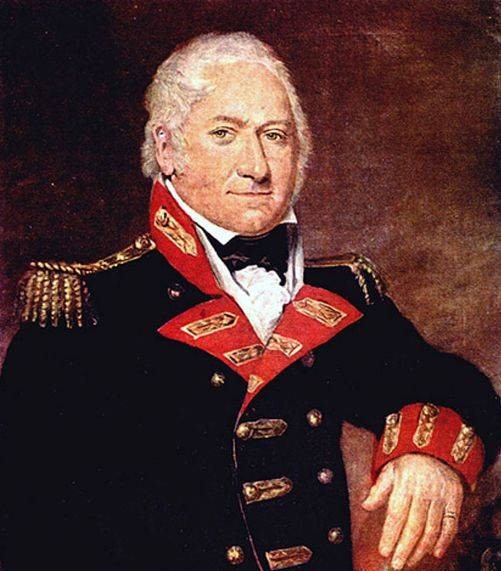 Henry Shrapnel
Henry Shrapnel
Henry Shrapnel, whom already descendants began to call "the killer of infantry and cavalry", started to create a new artillery ammunition at the end 18 century. The British Army officer's idea was, to combine two types of already known shells in a new weapon - a bomb and a buckshot. The first ammunition was a hollow core, filled with gunpowder, and with an ignition tube. The second one was a set of metal striking elements, which fit in the bag, either at the later stages of development into a cardboard, cylindrical metal packaging.
Shrapnel's idea was to combine the lethality of these two ammunition, from the bomb, he wanted to borrow the radius of destruction and the power of the explosion, and from buckshot the destructive effect of defeat of openly located infantry and cavalry of the enemy.
The birthplace of shrapnel can be called Gibraltar, where Lieutenant of the British Royal Artillery Henry Shrapnel was assigned to 1787 year. Here the inventor did more than just serve, but also seriously studied the experience of the Great Siege of Gibraltar (1779-1783 years), mainly the use of artillery by the opposing sides. Six months after arriving at the fortress, the lieutenant showed the commander of the British garrison his brainchild.
The date of the first experiment using shrapnel is considered 21 December 1787 of the year. An 8-inch mortar was used as a gun., which was charged with a hollow core, inside which was placed about 200 musket bullets and gunpowder necessary for the explosion. They were shooting from the fortress towards the sea from a hill about 180 meters above water level. The experiment was found to be successful, new ammunition exploded about half a second before meeting the water surface, the water literally boiled from being hit by hundreds of bullets.
At the officers present, including Major General O'Hara, the tests made a good impression, but the commander of the Gibraltar garrison did not dare to take the implementation of the project under his personal patronage.
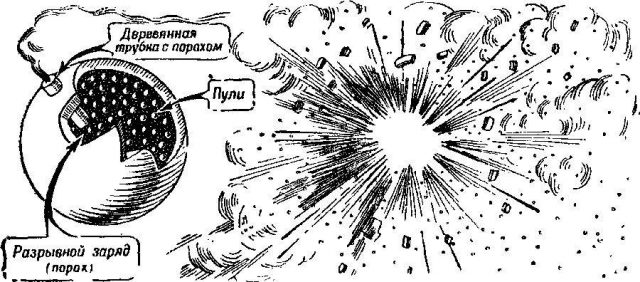 Shrapnel grenade
Shrapnel grenade
As a result, 1795 Henry Shrapnel returned to the British Isles with ideas, test results, but without the ammunition itself and the prospects for its production. Already in the rank of captain, he did not abandon his idea and took up the "favorite business of inventors" - active correspondence with all kinds of officials.
Continuing to improve the new ammunition, Henry Shrapnel prepared several reports to the Artillery Council Commission. Here his papers lay motionless for several years., after which the inventor received a refusal to support the work. However, Shrapnel was not going to give up and literally bombarded the commission with his messages and proposals., after all, the artillery officer knew a lot about conducting a good artillery preparation. As a result, in June 1803 bureaucratic British monster fell under the attacks of a persistent officer, positive feedback was received on his messages.
Despite the fact, that at that time the problem with the premature detonation of the ammunition was not fully resolved, the results of the tests carried out in England were recognized as successful and encouraging. The new artillery shell was included in the approved list of ammunition for the British field forces, and Henry Shrapnel himself 1 November 1803 years promoted, received the rank of major of artillery.
The grape grenade proposed by Officer Henry Shrapnel was made in the form of a hollow solid sphere., inside which was a charge of gunpowder, as well as bullets. The main feature of the grenade proposed by the inventor was a hole in the body., in which the ignition tube was placed. The ignition tube was made of wood and contained a certain amount of gunpowder. Such a tube served as both a moderator and a fuse..
When fired from a gun while still in the bore, gunpowder ignited in the ignition tube. Gradually, while the projectile was flying towards its target, gunpowder burned out, as soon as it burned out all, the fire was getting close to the powder charge, which was located in the hollow body of the grenade itself, what led to the explosion of the projectile. The effect of such an explosion is easy to imagine., it led to the destruction of the grenade body, which in the form of fragments along with bullets flew to the sides, hitting enemy infantry and cavalry.
A feature of the new projectile was that, that the length of the ignition tube could be adjusted by the gunners themselves even before the shot. Thanks to this solution, it was possible, with an acceptable level of accuracy at that time, to achieve a grenade explosion at the desired time and in the desired place..
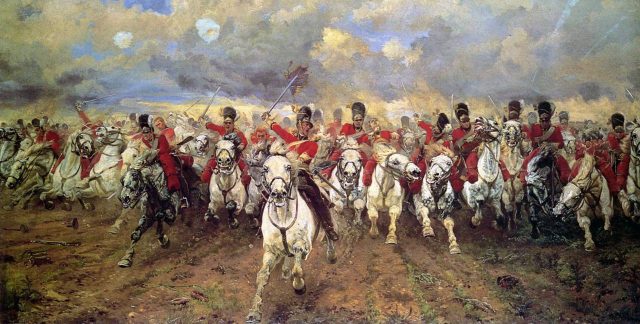 Attack of a brigade of light cavalry under fire of Russian artillery
Attack of a brigade of light cavalry under fire of Russian artillery
The brainchild of Henry Shrapnel was first tested in real combat conditions 30 April 1804 of the year. The debut of the new shell fell on the attack on Fort New Amsterdam, located in Dutch Guiana (Suriname). Major William Wilson, who in that battle led the actions of the British artillery, later wrote, that the effect of the new shrapnel shells was amazing. The garrison of New Amsterdam decided to surrender after the second volley, the Dutch were amazed at the, that they suffer losses from being hit by musket bullets at such a great distance from the enemy.
It should be noted here, that smooth-bore guns of that era could effectively fire grapeshot at a distance 300-400 m, while the nuclei flew a distance to 1200 m, the same was true for smoothbore guns, the firing range of which was limited 300 meters. In the same 1804 year Shrapnel was promoted to lieutenant colonel, later this artillery officer and inventor successfully rose to the rank of general and even received a salary from the British government in the amount of 1200 pounds per year (a very serious amount of money at that time), which also testifies to the recognition of his merits.
And shrapnel became more widespread.. In January 1806 years, new ammunition brought death and horror to the opponents of the British in southern Africa, where is the empire, over which the sun never set, regained control of the Cape Colony, after the new projectile was used in India, and in July 1806 years and in the battle of Maida. The new artillery ammunition quickly took its place in the sun and every year it was increasingly used in battles around the world..
A primordial British invention over time became widespread in the armies of all countries.. One of the examples of the successful use of shrapnel is the famous "light cavalry attack" during the Crimean War. 1853-1856 years. Best of all, it was described by a witness of the battle, General of the French army Pierre Bosquet: "It's great, but this is not war: This is madness". One can only agree with the French general, attack by the British light cavalry brigade, commanded by Lord Cardigan, made history. Poems were dedicated to this event, paintings, and then films.
The attack itself near Balaklava under the fire of Russian artillery, who used shrapnel, and shooters, located on the heights dominating the terrain, cost the British the loss of about half of the brigade's personnel and even more horses.
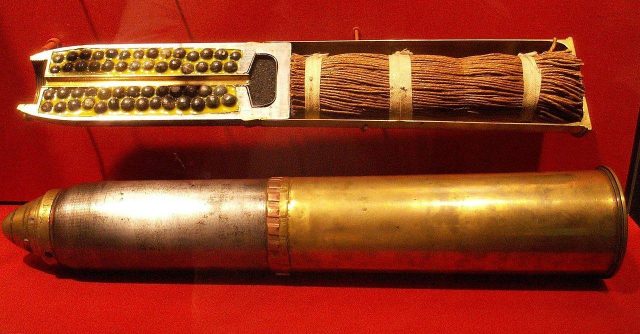 Diaphragm Shrapnel Projectile
Diaphragm Shrapnel Projectile
It is worth noting, that it was the Russian artillerymen who made their significant contribution to the improvement of the ammunition. The Russian Empire found its own Henry Shrapnel, took his place Russian scientist-artilleryman Vladimir Nikolaevich Shklarevich. After rifled guns had just begun to appear in the armies of the world, Vladimir Shklarevich introduced a new type of projectile - diaphragm shrapnel with a central tube and bottom chamber, it happened in 1871 year.
The presented ammunition looked like a cylindrical body, diaphragm (cardboard partition) it was divided into two compartments. An explosive charge was placed in the bottom compartment of Shklarevich's projectile. Ball-shaped bullets were placed in another compartment.. A central tube ran along the axis of the projectile., which was filled with pyrotechnic composition. A head with a capsule was placed on the front of the projectile.. After a shot from the gun, the capsule exploded and the slowly burning pyrotechnic composition in the longitudinal tube ignited..
In flight, the fire passed through the tube and reached the powder charge in the bottom compartment, which led to the explosion of the projectile. The occurring explosion pushed the diaphragm forward in the course of the projectile's flight, as well as the bullets behind it, which flew from the projectile. New schema, proposed by a Russian engineer, allowed the use of ammunition in modern rifled artillery.
The new projectile had its own significant plus. Now, when a projectile detonated, the bullets did not fly evenly in all directions, as originally happened when a spherical grenade of the Shrapnel design was detonated, and directed along the axis of flight of an artillery projectile with a deviation to the side from it. This solution increased the combat effectiveness of artillery fire when firing shrapnel..
The presented design also had a significant disadvantage., but it was quickly eliminated. The first projectile of Shklarevich provided for firing only at a predetermined distance. The deficiency was eliminated already in 1873 year, when the tube for remote detonation of a new ammunition with a rotary ring was created. The main difference was that, that now, from the capsule to the explosive charge, the fire was on the way, in three parts. One piece, as before, there was a central tube, and the two remaining sections were channels with the same pyrotechnic composition, but located in slewing rings. Turning data rings, gunners could change the amount of pyrotechnic composition, ensuring the detonation of shrapnel at the distance required during the battle.
At the same time, two terms appeared in the colloquial speech of artillery crews: the projectile is delivered "On shrapnel", if necessary, so that it explodes at a great distance from the weapon and "On a shotgun", if the distance tube was adjusted for the minimum burning time. The third option for the use of such projectiles was the position "On strike", when the path from the capsule to the explosive charge was completely blocked. In this position, the projectile exploded only at the moment of meeting with an obstacle..
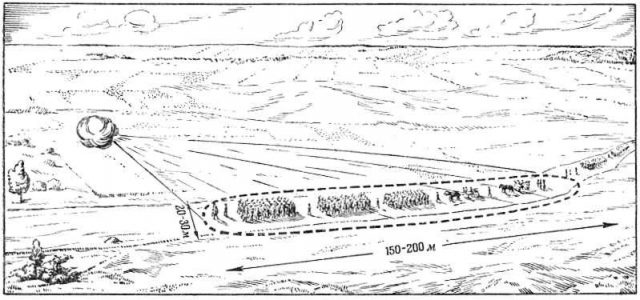
The use of shrapnel shells reached its peak by the beginning of the First World War.. According to the experts, for field and mountain artillery caliber 76 mm such shells constituted the vast majority of ammunition. At the same time, shrapnel was quite actively used by large-caliber artillery systems.. For example, in the 76-mm projectile was placed about 260 bullets, and in 107 mm it is already about 600.
In the event of a successful break, such a deadly swarm of lead could cover the area 20-30 meters wide and up to 150-200 meters deep - almost a third of a hectare. With a successful break, only one shrapnel could cover a section of a large road, along which the company was moving in the number of 150-200 a man with his machine-gun gig.
One of the most effective episodes of the use of shrapnel shells occurred at the beginning of World War I.. 7 August 1914 Captain Lombal, the commander of the 6th battery of the 42nd regiment of the French army, during the outbreak of the battle, was able to spot German troops at a distance of five kilometers from the location of his guns in time, who came out of the forest. Shrapnel shells from 75-mm guns were opened at the concentration of troops., 4 the guns of his battery made a total 16 shots.
The result of the shelling, who found the enemy at the time of restructuring from marching to battle formations, turned out to be disastrous for the Germans. As a result of an artillery strike, the 21st Prussian Dragoon regiment lost only the killed order 700 a person and about the same number of trained horses, after such a blow, the regiment ceased to be a combat unit.
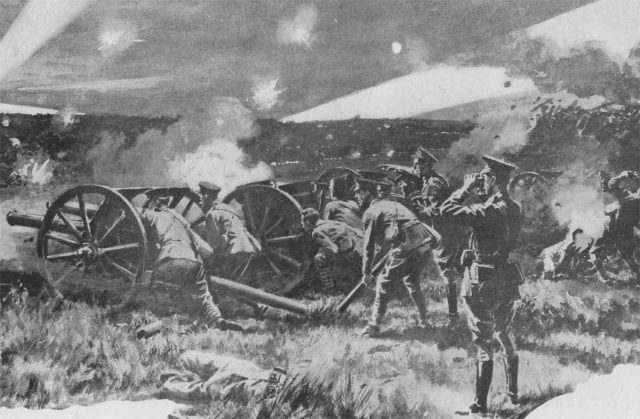 Fight during the First World War
Fight during the First World War
But by the middle of the First World War, when the sides switched to positional actions and the massive use of artillery, and the quality of the officers of the warring parties has fallen, cons of shrapnel began to appear. Among the main disadvantages were:
- small lethal effect of spherical shrapnel bullets (usually quite low-grade), any obstacle could stop them;
- powerlessness against goals, sheltered in the trenches, trenches (with a flat trajectory of fire), dugouts and caponings (for any trajectory);
- low effectiveness of long-range firing when using poorly trained officers, especially reservists;
- small damaging effect against the material part of the enemy, even openly located.
- great complexity and high cost of such ammunition.
For these reasons, even during the First World War, shrapnel was gradually replaced by a fragmentation grenade., with an instant fuse, which did not have the listed disadvantages and, moreover, was distinguished by a great psychological effect on the enemy soldier.
Gradually, the number of shrapnel in the troops decreased, but even during the Second World War, such ammunition was used quite massively, what search engines can tell you about, field workers. And the very use of shrapnel shells is reflected in fiction., for example, the famous story "Volokolamsk Highway".
In the second half of the 20th century, a shrapnel shell, a real threat to the infantry for over a century, practically ceased to be used, but the ideas themselves, on which this weapon was based, albeit in a modified version, they continue to be used today at a new level of development of science and technology.
/Sergey Yuferev, topwar.ru/







